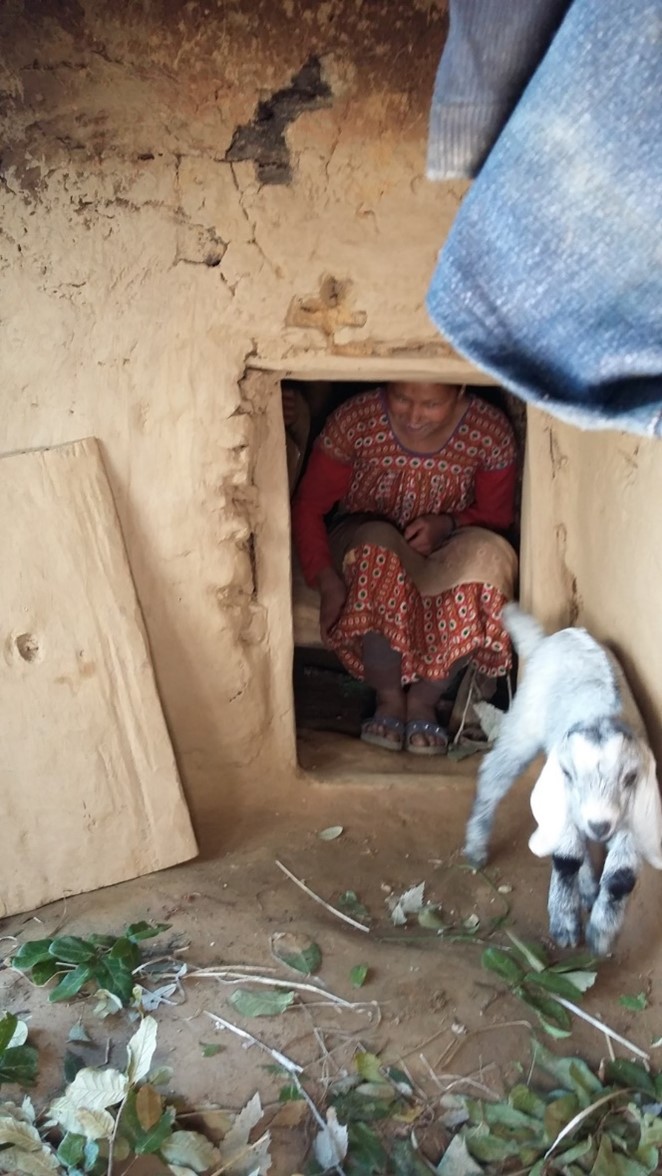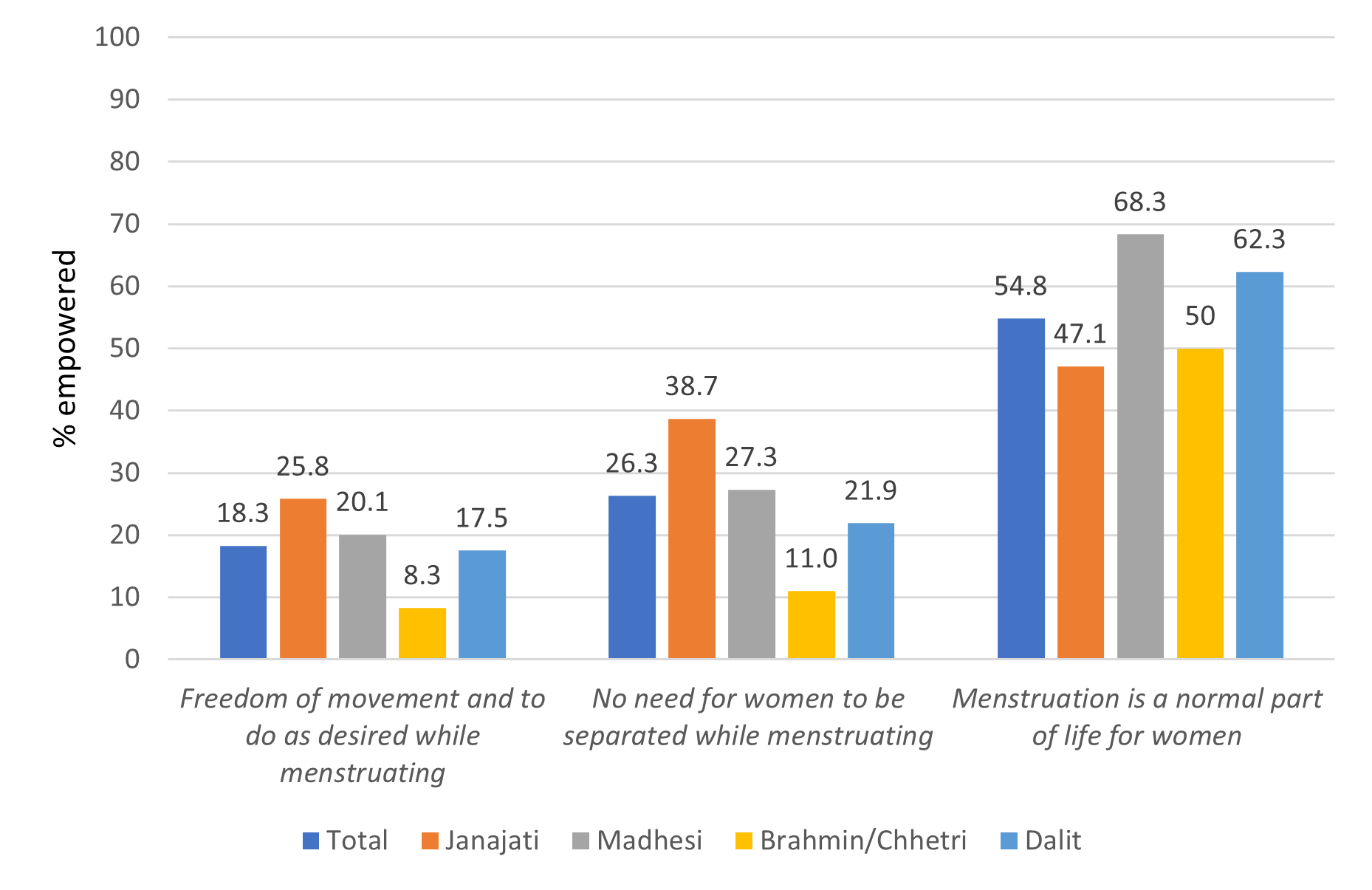Exploring menstrual taboos in Nepal using new empowerment indicators for water, sanitation and hygiene
 Nathaniel Ferguson/IFPRI
Nathaniel Ferguson/IFPRI
Taboos about menstruation in Nepal are strong and persistent, and limit women’s and girls’ activities. Desires to create gender equality in water, sanitation and hygiene (WASH) has prompted more work to measure women’s empowerment in the sector. We developed a dashboard of indicators that measures agency related to WASH. Here, we examine women’s empowerment as it relates to menstruation—specifically, three indicators that describe instrumental and intrinsic agency, that directly measure menstrual taboos, and that are likely the most difficult to change.
Women experience disproportionate burdens in the water, sanitation and hygiene (WASH) sector, so gender-sensitive WASH interventions are important for achieving gender equality. Consequently, there are growing efforts to measure women’s empowerment in WASH.
Recently, IFPRI and collaborators developed a dashboard of indicators titled Women’s Empowerment in WASH (WE-WASH), which addresses different forms of agency related to WASH—including the domains of the menstrual hygiene empowerment environment, and instrumental and intrinsic agency related to menstrual hygiene. A recent discussion paper outlines how we developed the dashboard.
To develop WE-WASH, we drafted a questionnaire that addressed different domains of agency in WASH, then conducted household surveys in rural Malawi and Nepal to test and refine our indicators—ending up interviewing 826 women and 826 men in Nepal. Using this data from both countries, we developed 14 indicators, only 13 of which were calculated for Nepal (data for one indicator was not collected in that country).
This blog focuses on the indicators related to menstrual hygiene in Nepal, examining women’s empowerment as it relates to menstruation—specifically, three indicators that describe instrumental and intrinsic agency, that directly measure menstrual taboos, and that are likely the most difficult to change.

A chhau goth (menstrual hut) for the practice of chhaupadi in Nepal. Credit: Pema Lhaki
Taboos about menstruation in Nepal are strong and persistent
In Nepal, there is a strong taboo attached to menstruation, based around the persistent idea—rooted in religion—that menstruation “pollutes.”
The practice of chhaupadi (“seclusion”) during a woman’s menstrual cycle persists despite nominal illegality. The practice involves the sequestering of women in sheds separate from their house. According to the 2022 Demographic and Health Survey (DHS), the practice is most common in the western provinces of Karnali and Sudurpashchim, where one-fifth and one-quarter of menstruating women between ages 15–49, respectively, were excluded from staying in the house during their latest menstrual period.
A less severe form of exclusion called chuna nahune (“untouchable phase”) is practiced in urban and educated families. This practice bars menstruating women from touching men in their family, sleeping in the same bed as family members, entering the kitchen, and touching water sources. According to the DHS report, eighty-five percent of women reported being excluded from at least one activity while menstruating. This exclusion has negative effects on the lives of girls and women, including by limiting school attendance.
Caste, ethnicity contribute to wide variability in indications of empowerment
WE-WASH includes five indicators specifically related to menstruation (see box 1).

Two indicators describe the menstrual hygiene empowerment environment; while these are important for the development of individual agency, they do not measure menstrual taboos directly. The other three indicators, which we focus on here, describe instrumental and intrinsic agency—these measure menstrual taboos directly and are likely more difficult to change.
We find that the proportion of respondents empowered in the instrumental and intrinsic agency indicators (see Figure 1) varies considerably by:
- caste/ethnicity, a significant driver of menstruation-related norms
and
- indicator—a higher proportion of respondents are empowered in the indicator titled Menstruation is a normal part of life for women than in the other two indicators
Indicator 1: Freedom of movement and to do as desired while menstruating

Figure 1: Women’s empowerment in selected indicators, by caste/ethnicity of household head
For this indicator, we asked women who had menstruated in the past year whether they avoided certain locations and activities because they were menstruating. We defined empowerment as not avoiding any locations or activities.
Overall, only 18.3 percent of respondents achieved empowerment. We find that 70 percent of women were excluded from religious activities (Figure 2) and 36 percent from food preparation, similar to the DHS report results. The differences by caste/ethnicity substantiate the higher levels of segregation during menstruation among the so-called “higher” castes of Brahmin/Chhetri; often the enforcers of religious practice.
Ritual (im)purity is a strong concept in Hinduism and is the source of many restrictions placed on menstruating women, who are considered “impure.” As it is mostly Brahmin men who serve as priests, Brahmin women (and the other “high” caste Chhetris) are expected to maintain strict adherence to ritual purity and are more commonly excluded from certain places and activities while menstruating. The religious roots of the menstrual taboo create deep-seated norms which are resistant to change.

Figure 2. Respondent avoidance of selected locations and activities while menstruating
Indicator 2: No need for women to be separated while menstruating
To construct the indicator No need for women to be separated while menstruating, we asked women if they believe that women should be separated from other people or places, or should not prepare food, while menstruating. Empowerment was defined as disagreement with all statements.
Only 26.3 percent of Nepali women achieved empowerment, by this measure. It is important to note that this indicator was weakly correlated with the indicator on freedom of movement, suggesting that what women believe women should do, and what they themselves do, measure different aspects of menstrual taboos.
Indicator 3: Menstruation is a normal part of life for women
The final indicator discussed here, Menstruation is a normal part of life for women, was similarly only asked of women. Unlike the preceding indicators, a majority of Nepali women (54.8 percent) were empowered in this indicator. Empowerment here means agreement with girls having practical knowledge of menstruation before their first period, the acceptability of treating the pain with medication, and a lack of shame when acquiring menstrual products.
As with the previous indicators, empowerment varies significantly across social identities, though the relative ordering of these groups is different; Janajati women, the most empowered in the other indicators, are the least empowered here. One possible reason for higher overall empowerment in this indicator relative to the first two (see Figure 1) is that attitudes that are changing among women could precede broader societal change, which is slowed by factors including:
- resistance from community leaders
- stigma faced by women who reject restrictions
- the limitations of laws, which cannot prevent voluntary adherence to restrictions
With our single cross-sectional survey, we can only hypothesize reasons for this divergence among indicators, and highlight this for future research.
These indicators may reveal attitudes changing faster than norms
Notably, most women in our sample view menstruation as a normal occurrence, but feel the pressure of taboos. Most women believe in teaching girls about menstruation, believe that it is acceptable to use pain medication, and feel no shame about acquiring menstrual products. However, most are also restricted in movement and activity during this “normal” occurrence and hold normative beliefs about the “need to be separated.”
Also notably, almost all women respondents agreed that Menstruation is a normal thing that happens to women, but nearly half felt “ashamed” while menstruating. Researchers in a 2014 study in Nepal were similarly struck by the prevalence of the belief that menstruation is a normal occurrence, simultaneously existing with exclusion. Once again, these gaps could reveal a context where women’s attitudes are changing faster than social norms, leading to a perceived dissonance between beliefs and practices.
Crucially, community interventions which aim to mitigate these restrictions must target women as well as men. Their effectiveness is also dependent on the engagement of community stakeholders, such as municipal and school officials, who may hesitate in moving to promote change, despite personal approval.

We collected data, for instance, from the Syangja District. Photo: Nathaniel Ferguson/IFPRI
References
Caruso BA, Conrad A, Patrick M, Owens A, Kviten K, Zarella O, et al. (2022) Water, sanitation, and women’s empowerment: A systematic review and qualitative metasynthesis. PLOS Water 1(6): e0000026. https://doi.org/10.1371/journal.pwat.0000026
Crawford, Mary et al. “‘This is a natural process’: managing menstrual stigma in Nepal.” Culture, health & sexuality vol. 16,4 (2014): 426-39. https://pubmed.ncbi.nlm.nih.gov/24697583/
Dickin, Sarah, Elijah Bisung, Juste Nansi, and Katrina Charles. “Empowerment in Water, Sanitation and Hygiene Index.” World Development 137 (January 1, 2021): 105158. https://doi.org/10.1016/j.worlddev.2020.105158.
Ministry of Health and Population [Nepal] and ICF. “Nepal Demographic and Health Survey 2022.” Kathmandu, Nepal: Ministry of Health and Population [Nepal], 2023. https://www.dhsprogram.com/pubs/pdf/FR379/FR379.pdf.
Morrison, Joanna, Machhindra Basnet, Anju Bhatta, Sangeeta Khimbanjar, and Sushil Baral. “Analysis of Menstrual Hygeine Practices in Nepal: The Role of WASH in Schools Programme for Girls Education 2016.” UNICEF, 2018. https://www.unicef.org/nepal/reports/analysis-menstrual-hygiene-practices-nepal
Sinharoy, Sheela S., Shauna McManus, Amelia Conrad, Madeleine Patrick, and Bethany A. Caruso. “The Agency, Resources, and Institutional Structures for Sanitation-Related Empowerment (ARISE) Scales: Development and Validation of Measures of Women’s Empowerment in Urban Sanitation for Low- and Middle-Income Countries.” World Development 164 (April 1, 2023): 106183. https://doi.org/10.1016/j.worlddev.2023.106183.
Thapa, Subash, and Arja R. Aro. “‘Menstruation Means Impurity’: Multilevel Interventions Are Needed to Break the Menstrual Taboo in Nepal.” BMC Women’s Health 21, no. 1 (February 28, 2021): 84. https://doi.org/10.1186/s12905-021-01231-6.